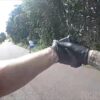A new discovery in the City of David National Park has provided rare material evidence of the presence of Greeks in ancient Jerusalem. During archaeological excavations operated by the Israel Antiquities Authority and Tel-Aviv University, 16 pieces of ceramic roof tiles were discovered. While researching, Dr. Filip Vukosavović, Dr. Anat Cohen-Weinberger and Dr. Yiftah Shalev from the Israel Antiquities Authority, Professor Yuval Gadot from Tel Aviv University and Efrat Bocher from Bar-Ilan University found roof tiles. The tiles discovered at the Givati Parking Lot Excavations in City of David National Park date back to the time period of Greek Seleucid King Antiochus IV Epiphanes. Their findings were published in the Journal of Hellenistic Pottery.Antiochus IV is known widely from the story of Hanukkah as the oppressor. The fragments of a rooftop were found in the City of David National Park. (Kobi Harati, City of David)700K-YEAR-OLD ARCHAEOLOGICAL SITE FOUND IN GREEK COAL MINE BELIEVED TO BE COUNTRY’S OLDEST He was a ruler who spread Greek culture to other territories. He enforced Hellenistic views in Jerusalem and desecrated the sacred temple in Jerusalem, causing a revolt of the Jewish people, known as the Maccabean revolt, according to the story in the book of the Maccabees. “When Antiochus IV and the Greeks arrive, and they conquer Jerusalem, they defile the temple, as we know from the proper story of Hanukkah,” Vukosavović told Fox News Digital. “They bring the knowledge with them. Why do they have the knowledge? Because these roof tiles, or at least modern roof tiles, were invented in the seventh century B.C., in the middle of Greece itself, and then spread around the world, but never to the Middle East.”Researchers were able to identify the roof tiles as ones from this time period using a process called stratigraphy.”We can date each strata about the contents of that strata. And, for the most part, it depends on the pottery itself. We know that during certain periods, certain types of pottery, meaning vessels, pottery vessels were used,” Vukosavović explained. Further testing was done to discover whether these roof tiles were made in Israel or brought by the Greeks. (Emil Aladjem, Israel Antiquities Authority)ARCHAEOLOGISTS IN NORWAY CLAIM TO HAVE FOUND WORLD’S OLDEST RUNESTONE”In this case, it was really both the coins and the pottery itself that showed us that the strata or the layer where these roof tiles were found was sealed in the second century B.C.E., so we know that couldn’t have been later,” Vukosavović continued. To gain more extensive knowledge about these tiles, Weinberger performed a petrography analysis to get a better understanding of where these roof tiles were made. Before this test was done, it was still unknown whether these tiles were brought by the Greeks or if they were made locally upon their arrival in Jerusalem. “Weinberger proved that the material is local, the clay is local, from an area west of Jerusalem called the Motza … with the addition of sand and straw, which are also local,” Vukosavović said.  To obtain his power, Antiochus IV built a fortress known as the “Acra.” There has often been mystery surrounding the fortress, especially regarding its exact location, a question pondered for decades. A few years ago, there were walls discovered belonging to an ancient fortress. This provided good material evidence proving its existence but could not stand as proof alone. The discovery of roof tiles near these walls makes a strong argument that the fortress was, in fact, in that location, according to Vukosavović.Ceramic roofing tiles were invented in Greece and became popular due to their durability and water resistance. They weren’t commonly used in Israel until hundreds of years later. The presence of these materials in the city can be connected to Antiochus IV himself. Filip Vukosavović spoke to Fox News Digital about the monumental findings. (Emmanuel Dunand/AFP via Getty Images)HANUKKAH QUIZ: SEE HOW MUCH YOU KNOW ABOUT THE JEWISH HOLIDAYThe discovery provides material proof of a story often told. “Other than the Acra, this fortress, these roof tiles are also very clear proof for the presence of the Greeks during the same time period,” Vukosavović said. “The first book of Maccabees describes the arrival of the Greeks, Antiochus IV and the struggle. “And then much later tradition talks about the defilement of the temple and the miracle of the oil and eight days. That’s why today all the Jews celebrate Hanukkah, but we have never really had real material proof for the presence of the Greeks themselves.” The discovery of these roof tiles provides physical proof to support details of the story of Hanukkah known today. (Eliyahu Yannai, City of David National Park)CLICK HERE TO GET THE FOX NEWS APP The Israel Antiquities Authority Conference is planned for Dec. 11, 2023, at the Jay and Jeanie Schottenstein National Campus for the Archeology of Israel. The event will include lectures and an event led by Vukosavović, who will present photos of the fragments found and talk about his discovery. Ashlyn Messier is a writer for Fox News Digital.Â
Breaking News
2024-10-27 A man who abused up to 3,500 girls online has been sentenced for crimes including manslaughter
2024-10-27 Rear Admiral Claims Government COVERED UP Alien Contact. We’ve Talked with ALIENS????
2024-10-27 BREAKING: UN Sec Council Passes Gaza Aid, US Sits Out; Trump Audio EXPOSES Pressure On MI Officials
2024-10-27 Missing Juvenile Aamina Turner from the 12th District – Blotter
2024-10-27 Missing Endangered Person Ivelisse Lugo from the 2nd District – Blotter
Static News
500k views later The FLORIDA...
phillynews215 2021-04-27 50 Comments on Body Cam: Officer Fatal Shooting Man with a Sword – Pomona Police March 30- 2020
#officerinvolvedshooting #policeshooting #Pomona Policedepartment Please...
phillynews215 2021-04-27 50 Comments on Bodycam Shows Deputies Shooting Armed Suspect in Greenville, South Carolina
** (Disclaimer: This video content...
Video brought to you by...
Rafael Nieves 2024-10-27 0 Comment on A man who abused up to 3,500 girls online has been sentenced for crimes including manslaughter
A "relentless and cruel" online...
Rafael Nieves 2024-10-27 38 Comments on Rear Admiral Claims Government COVERED UP Alien Contact. We’ve Talked with ALIENS????
Robby Soave and Briahna Joy...
Rafael Nieves 2024-10-27 0 Comment on BREAKING: UN Sec Council Passes Gaza Aid, US Sits Out; Trump Audio EXPOSES Pressure On MI Officials
The Hill’s Kevin Cirilli recaps...
Rafael Nieves 2024-10-27 0 Comment on Missing Juvenile Aamina Turner from the 12th District – Blotter
The Philadelphia Police Department is...
Rafael Nieves 2024-10-27 0 Comment on Missing Endangered Person Ivelisse Lugo from the 2nd District – Blotter
The Philadelphia Police Department is...
phillynews215 2024-04-15 6 Comments on #KO – Oscar Duarte vs Humberto De Santiago Desde Chihuahua, Mexico!
October 19th, 2019 - Chihuahua,...
U.S. Secretary of State Antony...
phillynews215 2024-03-23 Comments Off on Chinese coast guard uses water cannon on Philippine boat as tensions rise near Second Thomas Shoal
Join Fox News for access...
Just so we are clear:...
phillynews215 2022-09-27 Comments Off on Suspects for Robbery in the 9th District [VIDEO] – Blotter
On September 9, 2022, at...
Proudly powered by ANGELHOUSE 2009 - 2024 | ALL YOUTUBE VIDEOS IS A REGISTERED TRADEMARK OF GOOGLE INC. | THE YOUTUBE CHANNELS AND BLOG FEEDS IS MANAGED BY THE RIGHTFUL OWNERS/CREATORS HOSTING BY PHILLYFINESTSERVERSTATS INC. ALL RIGHTS RESERVED



















![Suspects for Robbery in the 9th District [VIDEO] – Blotter](https://www.phillynewsnow.com/wp-content/uploads/2022/09/Robbery-4xx-N-19th-St-DC-22-09-032190-100x100.jpg)